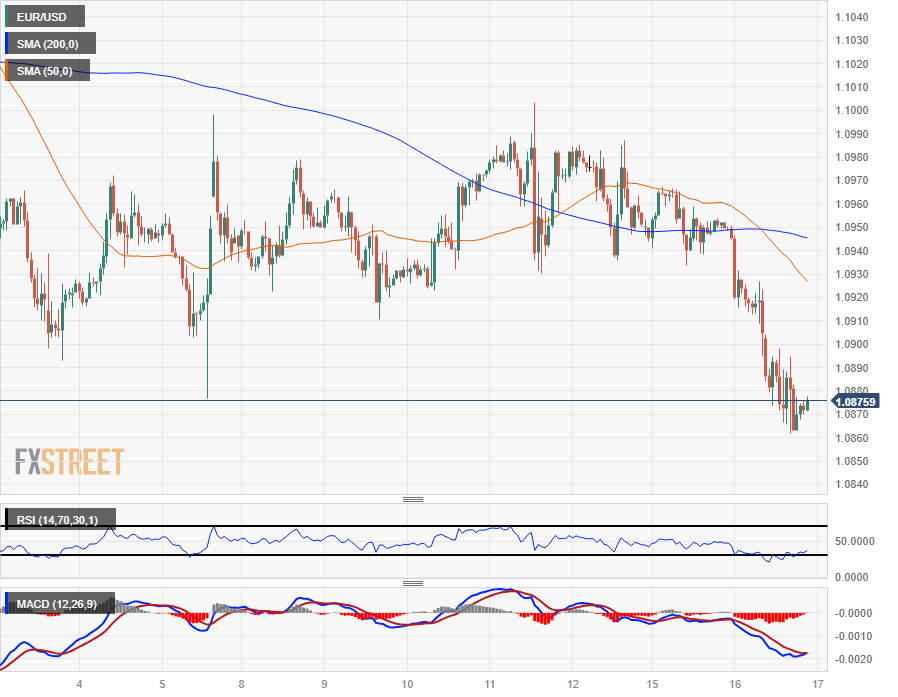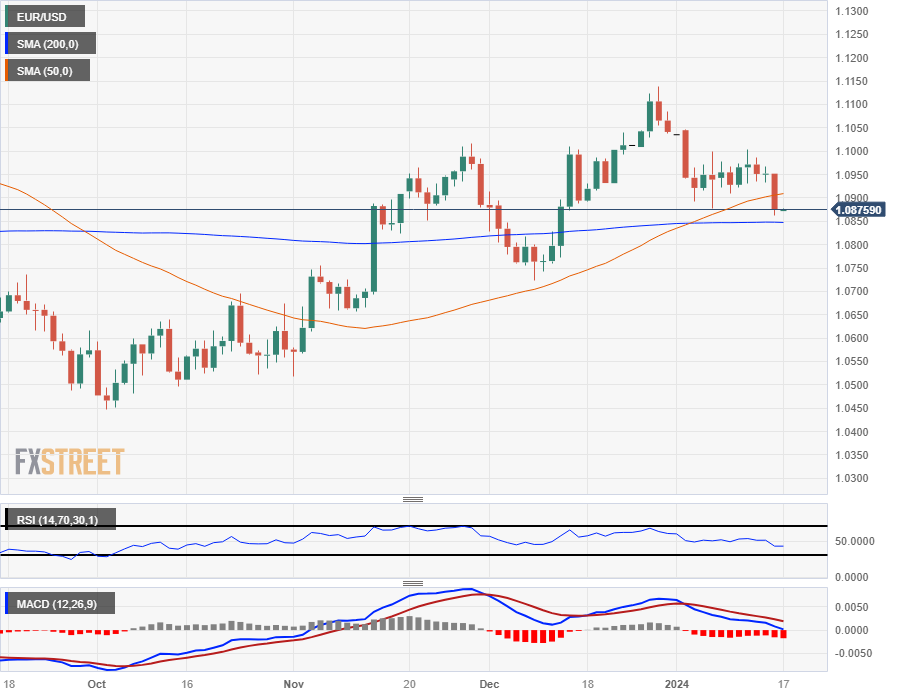Euro backslides against Greenback as ECB talks down rate movement expectations
- The Euro tumbled against the high-stepping US Dollar on Tuesday.
- ECB’s Senteno, Villeroy, and Nagel reiterate familiar policy stance.
- ZEW Economic expectations in Germany improved, because of rate cut hopes.
The Euro (EUR) mixed on Tuesday, holding mostly steady against its peers but seeing steep declines against the US Dollar (USD). European Central Bank (ECB) officials continue to tow the company line, reiterating that it’s too soon for the ECB to pivot into rate cuts.
Euro area data was thin on Tuesday, and markets will be focusing on headlines from the World Economic Forum (WEF) in Davos, Switzerland where policymakers are meeting for a five-day retreat.
Daily digest market movers: Euro tumbles against US Dollar as policymakers talk down markets
- The euro area’s ZEW Economic Sentiment Survey in January declined slightly from 23.0 to 22.7, but beat the forecast decline to 21.9.
- Germany’s ZEW Economic Sentiment Survey improved in January, jumping from 12.8 to 15.2 versus the forecast 12.0.
- Germany’s ZEW Current Situation Survey deteriorated further, dropping from -77.1 to 7.3 versus the expected uptick to -77.0.
- ECB’s Valimaki: ECB will continue to be data-dependent, better to wait longer than to cut too early.
- Can’t jump the gun too early on rate changes.
- Restrictive monetary policy still called for according to ECB’s Valimaki.
- ECB’s Centeno: Inflation is coming down sustainably, shouldn’t be worried about a resurgence in inflation rate.
- ECB needs to be prepared for all topics, including rate cuts, according to ECB’s Centeno.
- ECB’s Villeroy: Still too early to declare victory over inflation.
- ECB’s Villeroy reaffirms that the ECB’s next move will be a rate cut sometime this year, but inflation outlook needs to see 2% first.
- The ECB is more patient on rate cut outlook than markets, according to ECB’s Villeroy.
Euro price today
The table below shows the percentage change of Euro (EUR) against listed major currencies today. Euro was the strongest against the Australian Dollar.
| USD | EUR | GBP | CAD | AUD | JPY | NZD | CHF | |
| USD | 0.64% | 0.62% | 0.42% | 0.99% | 0.95% | 0.84% | 0.66% | |
| EUR | -0.64% | 0.00% | -0.20% | 0.35% | 0.31% | 0.20% | 0.02% | |
| GBP | -0.64% | 0.00% | -0.21% | 0.36% | 0.31% | 0.19% | 0.02% | |
| CAD | -0.43% | 0.20% | 0.20% | 0.56% | 0.52% | 0.41% | 0.23% | |
| AUD | -1.00% | -0.35% | -0.36% | -0.57% | -0.04% | -0.14% | -0.33% | |
| JPY | -0.96% | -0.31% | -0.33% | -0.54% | 0.03% | -0.11% | -0.30% | |
| NZD | -0.84% | -0.19% | -0.20% | -0.42% | 0.15% | 0.12% | -0.18% | |
| CHF | -0.66% | -0.02% | -0.02% | -0.23% | 0.34% | 0.29% | 0.18% |
The heat map shows percentage changes of major currencies against each other. The base currency is picked from the left column, while the quote currency is picked from the top row. For example, if you pick the Euro from the left column and move along the horizontal line to the Japanese Yen, the percentage change displayed in the box will represent EUR (base)/JPY (quote).
Technical Analysis: Euro sheds weight against firmer US Dollar, mixed on Tuesday
The Euro (EUR) slid around two-thirds of a percent against the US Dollar on Tuesday, also declining about a fifth of a percent against the Canadian Dollar (CAD), while gaining around a third of a percent against both the Australian Dollar (AUD) and Japanese Yen (JPY).
The EUR/USD fell to its lowest bids since mid-December, knocking below the 1.0900 handle and testing into 1.0870 as bearish pressure builds enough to knock the pair out of near-term consolidation.
The EUR/USD is approaching the 200-day Simple Moving Average (SMA) near 1.0850, cutting cleanly through the 50-day SMA at 1.0900 as the pair heads into a technical congestion zone. Short-sellers will be looking for a continued push into December’s bottom bids near 1.0750, while a price action rebound from here will keep a higher-lows pattern intact and allow bidders to push for a rebound into the 1.1000 major handle.
EUR/USD Hourly Chart
EUR/USD Daily Chart
Euro FAQs
What is the Euro?
The Euro is the currency for the 20 European Union countries that belong to the Eurozone. It is the second most heavily traded currency in the world behind the US Dollar. In 2022, it accounted for 31% of all foreign exchange transactions, with an average daily turnover of over $2.2 trillion a day.
EUR/USD is the most heavily traded currency pair in the world, accounting for an estimated 30% off all transactions, followed by EUR/JPY (4%), EUR/GBP (3%) and EUR/AUD (2%).
What is the ECB and how does it impact the Euro?
The European Central Bank (ECB) in Frankfurt, Germany, is the reserve bank for the Eurozone. The ECB sets interest rates and manages monetary policy.
The ECB’s primary mandate is to maintain price stability, which means either controlling inflation or stimulating growth. Its primary tool is the raising or lowering of interest rates. Relatively high interest rates – or the expectation of higher rates – will usually benefit the Euro and vice versa.
The ECB Governing Council makes monetary policy decisions at meetings held eight times a year. Decisions are made by heads of the Eurozone national banks and six permanent members, including the President of the ECB, Christine Lagarde.
How does inflation data impact the value of the Euro?
Eurozone inflation data, measured by the Harmonized Index of Consumer Prices (HICP), is an important econometric for the Euro. If inflation rises more than expected, especially if above the ECB’s 2% target, it obliges the ECB to raise interest rates to bring it back under control.
Relatively high interest rates compared to its counterparts will usually benefit the Euro, as it makes the region more attractive as a place for global investors to park their money.
How does economic data influence the value of the Euro?
Data releases gauge the health of the economy and can impact on the Euro. Indicators such as GDP, Manufacturing and Services PMIs, employment, and consumer sentiment surveys can all influence the direction of the single currency.
A strong economy is good for the Euro. Not only does it attract more foreign investment but it may encourage the ECB to put up interest rates, which will directly strengthen the Euro. Otherwise, if economic data is weak, the Euro is likely to fall.
Economic data for the four largest economies in the euro area (Germany, France, Italy and Spain) are especially significant, as they account for 75% of the Eurozone’s economy.
How does the Trade Balance impact the Euro?
Another significant data release for the Euro is the Trade Balance. This indicator measures the difference between what a country earns from its exports and what it spends on imports over a given period.
If a country produces highly sought after exports then its currency will gain in value purely from the extra demand created from foreign buyers seeking to purchase these goods. Therefore, a positive net Trade Balance strengthens a currency and vice versa for a negative balance.